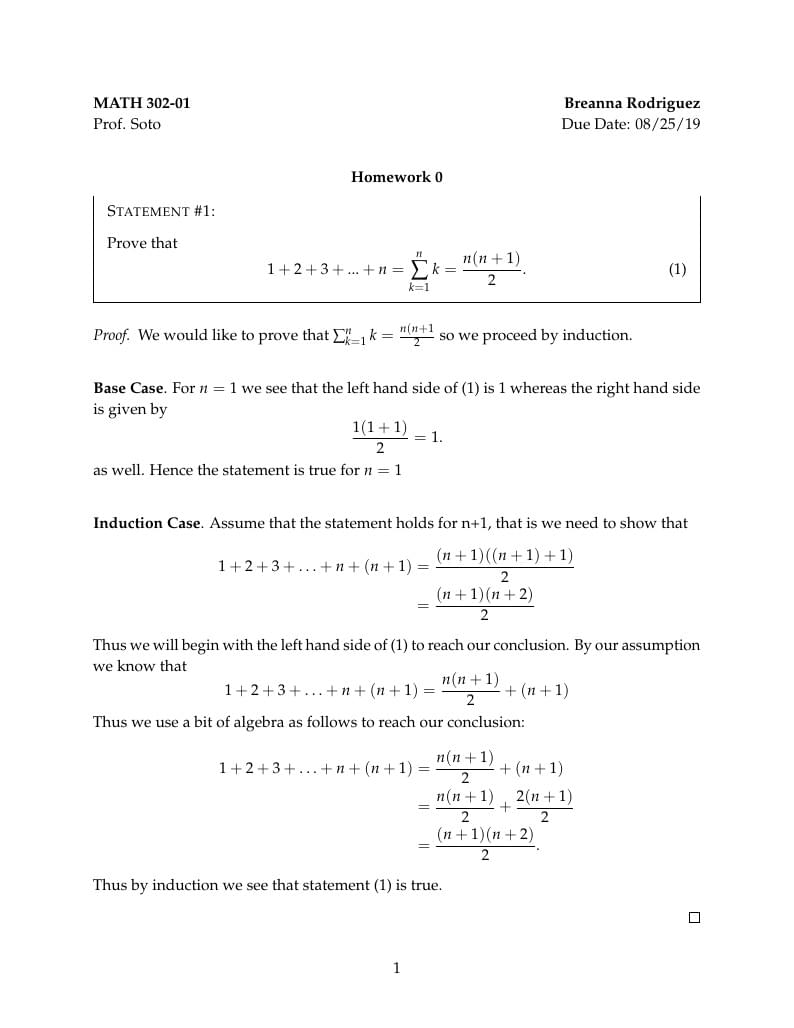
Math 302 HW 0 - B. Rodriguez
Auteur:
Breanna Rodriguez
Last Updated:
il y a 6 ans
License:
Creative Commons CC BY 4.0
Résumé:
HW 0

\begin
Discover why over 20 million people worldwide trust Overleaf with their work.
HW 0

\begin
Discover why over 20 million people worldwide trust Overleaf with their work.
\documentclass[12pt]{article}
\usepackage[top=1in, bottom=1in, left=1in, right=1in]{geometry}
%\usepackage[margin=1in]{geometry}
\usepackage[onehalfspacing]{setspace}
%\usepackage[doublespacing]{setspace}
\usepackage{amsmath, amssymb, amsthm}
\usepackage{enumerate, enumitem}
\usepackage{fancyhdr, graphicx, proof, comment, multicol}
\usepackage[none]{hyphenat} % This command prevents hyphenation of words
\binoppenalty=\maxdimen % This command and the next prevent in-line equation breaks
\relpenalty=\maxdimen
% Good website with common symbols
% http://www.artofproblemsolving.com/wiki/index.php/LaTeX%3ASymbols
% How to change enumeration using enumitem package
% http://tex.stackexchange.com/questions/129951/enumerate-tag-using-the-alphabet-instead-of-numbers
% Quick post on headers
% http://timmurphy.org/2010/08/07/headers-and-footers-in-latex-using-fancyhdr/
% Info on alignat
% http://tex.stackexchange.com/questions/229799/align-words-next-to-the-numbering
% http://tex.stackexchange.com/questions/43102/how-to-subtract-two-equations
% Text align left-center-right
% http://tex.stackexchange.com/questions/55472/how-to-make-text-aligned-left-center-right-in-the-same-line
\usepackage{microtype} % Modifies spacing between letters and words
\usepackage{mathpazo} % Modifies font. Optional package.
\usepackage{mdframed} % Required for boxed problems.
\usepackage{parskip} % Left justifies new paragraphs.
\linespread{1.1}
\newenvironment{problem}[1]
{\begin{mdframed}[linewidth=0.6pt]
\textsc{Problem #1:}
}
{\end{mdframed}}
\newenvironment{solution}
{\textsc{Solution:}\\}
{\newpage}% puts a new page after the solution
\newenvironment{statement}[1]
{\begin{mdframed}[linewidth=0.6pt]
\textsc{Statement #1:}
}
{\end{mdframed}}
%\newenvironment{prf}
% {\textsc{Proof:}\\}
% {\newpage}% puts a new page after the solution
\newcommand{\R}{\mathbb{R}}
\newcommand{\C}{\mathbb{C}}
\newcommand{\Z}{\mathbb{Z}}
\newcommand{\N}{\mathbb{N}}
\newcommand{\Q}{\mathbb{Q}}
\begin{document}
% This is the Header
% Make sure you update this information!!!!
\noindent
\textbf{MATH 302-01} \hfill \textbf{Breanna Rodriguez} \\
\normalsize Prof. Soto \hfill Due Date: 08/25/19 \\
% This is where you name your homework
\begin{center}
\textbf{Homework 0}
\end{center}
% This is how you call the environment for the statement to be proved.
\begin{statement}{\#1}
Prove that
\begin{equation}
\label{bree}
1 + 2 + 3+...+ n = \sum_{k=1}^n k = \frac{n(n+1)}{2}.
\end{equation}
\end{statement}
% This is how you call the proof environment
\begin{proof}
We would like to prove that $ \sum_{k=1}^n k = \frac{n(n+1}{2}$ so we proceed by induction. \\
\textbf{Base Case}. For $n = 1$ we see that the left hand side of (\ref{bree}) is 1 whereas the right hand side is given by
$$ \frac{1(1+1)}{2}= 1. $$
as well. Hence the statement is true for $n =1$ \\
\textbf{Induction Case}. Assume that the statement holds for n+1, that is we need to show that
\begin{align*}
1 + 2 + 3 + \dotsc + n + (n+1) &= \frac{(n+1)((n+1)+1)}{2} \\
& = \frac{(n+1)(n+2)}{2}
\end{align*}
Thus we will begin with the left hand side of (\ref{bree}) to reach our conclusion. By our assumption we know that
$$ 1 + 2 + 3 + \dotsc + n + (n+1) = \frac{n(n+1)}{2} + (n+1)
$$
Thus we use a bit of algebra as follows to reach our conclusion:
\begin{align*}
1 + 2 + 3 + \dotsc + n+ (n+1) & = \frac{n(n+1)}{2}+ (n+1) \\
& = \frac{n(n+1)}{2} + \frac{2(n+1)}{2} \\
& = \frac{(n+1)(n+2)}{2}.
\end{align*}
Thus by induction we see that statement (\ref{bree}) is true.
\end{proof}
\end{document}